100-year-old gaff ketch: Besanewer "Johanna" - museum, film star, contemporary witness
Stefan Schorr
· 15.12.2024
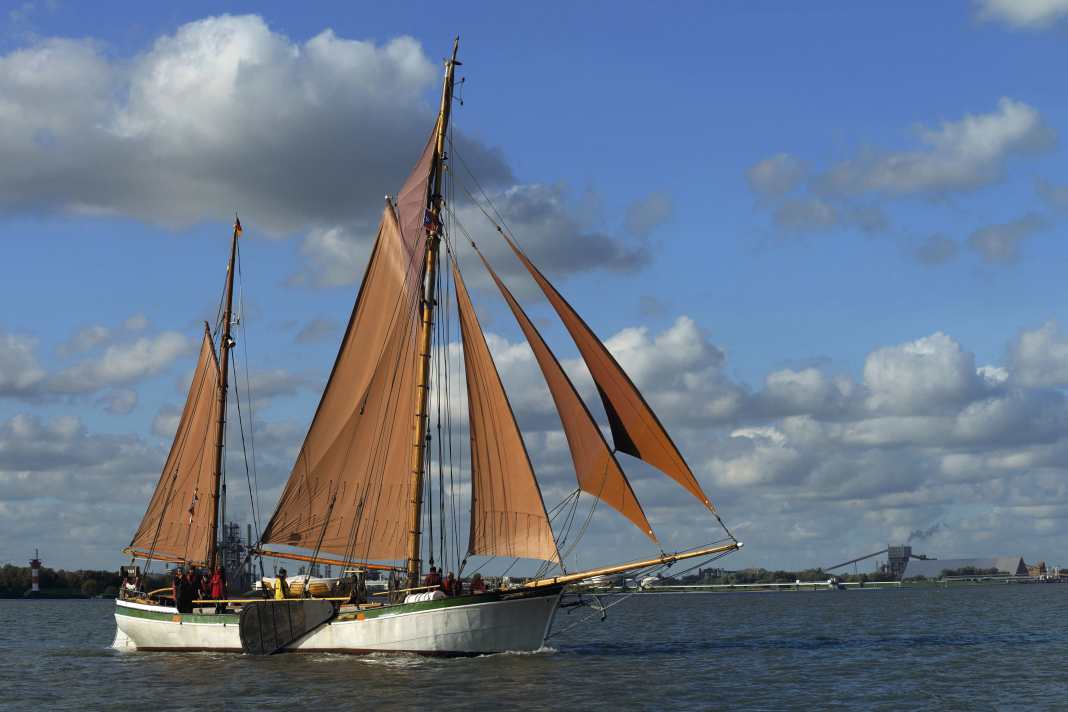





"Ready for the turnaround? Ree." Skipper Achim Elfers pushes the 4.5 metre long, solid wooden tiller to port. Gently but firmly, the bow of the "Johanna" turns to windward. Jager, jib and foresail come back, are overtaken and the mizzen sails continue to cross upstream on the Elbe on this sunny October day. Walkers on the banks of Stadersand stop to take photos, as the sight of the 100-year-old gaff-rigged ketch under full sail is reminiscent of times long past.
Ewers supplied Hamburg across the Elbe
Until the middle of the 20th century, the ewers with their flat hulls and centreboards made up the main part of an impressive fleet of small cargo ships on the Elbe. Together with sternboats, sailing barges, luggers and schooners, they ensured the transport of goods between Hamburg and the Lower Elbe marshes. Building materials from the brickworks on the Lower Elbe were sailed to Hamburg, as were fruit and vegetables from the Altes Land region or even larger pieces of luggage.
From 1900 onwards, the formerly wooden barges were increasingly built in composite construction with metal frames, before steel was used for the complete hulls.
From Elbe glider to inland waterway vessel with motor
The story of the "Johanna" cruising on the Elbe begins in 1902, when the Elbe skipper Heinrich Vöge from Barnkrug commissions the Elmshorn shipbuilder Johannes Thormählen to construct a mizzen barge. The hull is mainly riveted together from iron plates, but the flat floor is made from solid softwood as before. The skippers trust the wooden floor even more. For the smaller shipyards, this combination also offers the advantage that the older shipwrights can continue to be employed.
Bricks, fruit, vegetables, larger pieces of luggage: The "Johanna" transported goods between Hamburg and the Elbe marshes
The Ewer is launched in 1903. It is named after Vögele's wife Hertha. Two crew members sail the almost 19 metre long gaff ketch. As was customary at the time, Vöge is both owner and skipper. Just nine years later, Heinrich Vöge sells the ewer on to Abbenfleth for 6,000 marks.
From 1918, "Hertha" belonged to the Wehlen family from Stade for over 30 years. They frequently sailed salt from the Stade salt works to Hamburg and had the masts of the increasingly uneconomical ship removed at the end of the 1920s. In 1928, a 28 hp two-cylinder glow-head engine was installed in Hamburg-Bergedorf. From then on, the ewer, now registered as an inland vessel, sailed the Elbe with considerable noise. In 1950, a skipper from Hechthausen is said to have purchased the "Hertha" and renamed her "Ingeborg" before selling her on to Wilster in 1954. From there, the cargo ship was used for goods transport on the Elbe and its tributaries. Until the great storm surge.
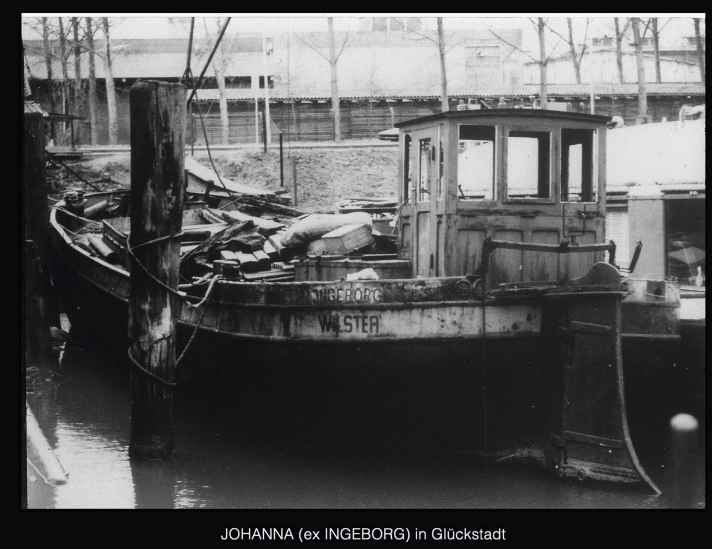
"Johanna" fell victim to the storm surge of 1962
On the fateful night of the storm surge from 16 to 17 February 1962, the "Ingeborg" hits a pile in Elmshorn harbour and its wooden floor is severely damaged. This meant the final economic end. "... for 3,000 marks, the last skipper sold the ewer to the Brockmöller shipyard, where from then on it was used as a dock and started to rust," wrote shipping journalist Joachim Kaiser in his 1977 book "Segler in der Zeitenwende" (Sailors at the Turn of the Century). For twelve years, "Ingeborg" lay as a dockyard barge in Glückstadt harbour.
The ewer also set off from Glückstadt today. From the "Rhinplate Rund" gaff meeting, it sails up the Elbe to its berth in the Finkenwerder cutter harbour. The regular crew and their guests are in high spirits and master one tack after another. Today's individual bookers are given an insight into traditional seamanship on board. They are allowed to help set the sails by hand, as well as now in the tacks when operating the centreboards with their chains and buoys. Those who wish can even steer "Johanna" themselves with the long tiller - under supervision.
Second life as a museum ship
Egon Heinemann found the ewer in Glückstadt in 1974 when he was looking for a suitable museum ship for his publishing house Chronik der Seefahrt. "Ingeborg" is the last ship of its kind on the entire Elbe that is still largely in its old state of construction and in fairly good condition. The publisher buys the ewer for DM 4,000 and has it towed from Glückstadt to Richard Schlegel's engine workshop in Heiligenstedten on the Stör. Once the glow-head engine was ready to run again, "Ingeborg" travelled to Hamburg under its own power.
In 1975, a shipyard is found there that dares to tackle the restoration of the Ewer. Günter Muche has the former Jastram barge shipyard in Allermöhe on the Dove Elbe well equipped for a wide range of restoration work. He begins with the conscientious removal of ageing damage and subsequent conversions, such as the wheelhouse aft.
In 1978, the "Piekfall. Mitteilungsblatt für die Freunde des Gaffelriggs": "A good 50 years of maritime history were launched at the Allermöher shipyard. In four years of painstaking work, the workers at the shipyard restored the 1903-built Besanewer on behalf of the Hamburg publisher 'Chronik der Seefahrt'. The wife of the publisher Egon Heinemann christened the ship with her first name 'Johanna'."
"The most beautiful arse of all ewers"
The wooden ship's floor was restored, as were the iron plating, hatches and decks. The masts, centreboards, rigging and sails were rebuilt. The Ewer's former cargo hold was lined with wood and converted into a small museum for Elbe, inland and coastal shipping. Why would a publisher do something like this? "We publish a lot of books about sailing ships. With this launch, I wanted to show that we don't just support the history of old sailing ships in theory," Heinemann was quoted as saying at the time. In 1976, Heinemann founded the Oevelgönne Museum Harbour Association together with Wolfgang Friederichsen, Joachim Kaiser, Uwe Kutzner, Volkwin Marg and Michael Thönnessen. Naturally, his ewer now has a berth in the museum harbour, which was the first in Germany to be opened in 1977. From here, "Johanna von Neumühlen" sailed on the Elbe and Baltic Sea until Egon Heinemann died in 1984.
We wanted to show that we don't just support the history of the old sailors in theory." (Egon Heinemann)
"So 'Johanna' has been under sail again since 1978," says skipper Achim Elfers. "That's significantly longer than her previous life as a cargo ship." What's more, she is still one of the most consistently restored Ewerns, of which only a few dozen have been preserved. "She is built slightly wider than the barges that had to fit through the Stör lock," explains Elfers. "That's why I think she has the best arse of all the barges."
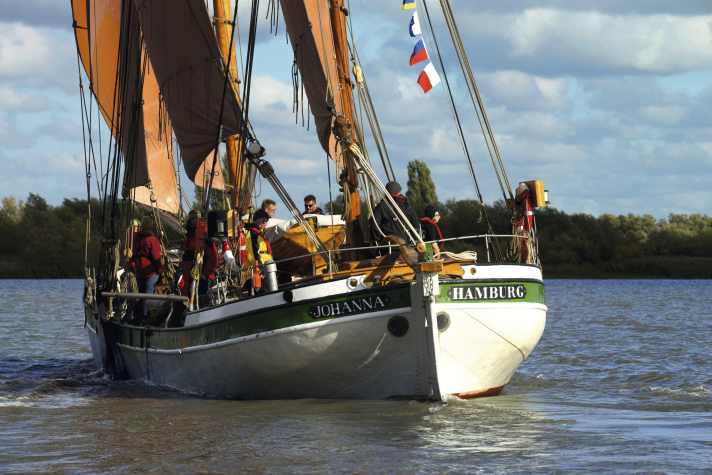
"Johanna" becomes the series heroine in "The Riddle of the Sandbank"
In the mid-1980s, "Johanna" arouses the interest of some Radio Bremen employees who are looking for suitable ships for planned filming in the Oevelgönne museum harbour. Erskine Childers' spy novel "The Riddle of the Sandbank" is to be filmed as a television series. Achim Elfers, born in 1958, has sailed on the "Rosinante", Ilo von Waltershausen's Dutch IJssel-Aak, in recent years. The two friends realise that the "Johanna" fits in well with the demands of the television people.
Von Waltershausen approaches Heinemann's heirs with a view to chartering the Ewer for filming and buys the ship from them. Filming takes place in Tetenbüll on Eiderstedt, Brunsbüttel, on Norderney and, of course, in the mudflats. Johanna" appears as "Cormoran" in the opening scene of the TV series, which was first broadcast in 1985. "I'll get Schenkel and the others. We'll get him in. He'll never make it." Achim Elfers still remembers his exact words, which he says on the forecastle of the Ewer as Arthur Davies fights his way to Bensersiel in stormy weather with his "Dulcibella".
The ship's floor is in the Museum of Hamburg History
"I got DM 200 for the three sets back then," he says, "as crew we got 37 marks a day and as extras we could add another 50." For the owner of Waltershausen, the charter formed the basis for an extensive shipyard stay. Immediately after several months of filming, the leaking wooden ship floor was removed at Eckmann's shipyard in Finkenwerder. Part of it can still be seen today in the Museum of Hamburg History. A completely new floor section is made from steel plates and welded on.
The first glow-head engine of the "Johanna" can be viewed in the show depot of the Hamburg Harbour Museum at the Hansa Harbour. At the time, it was replaced by a two-cylinder, two-stroke diesel engine, which at 50 hp was still not particularly powerful.
In 1986, Ilo von Waltershausen founded the association "Segelnde Museumsschiffe Hamburg e. V." and from then on regularly travelled with children and young people on the Baltic Sea, in the German mudflats and on the Elbe. In November 2002, von Waltershausen sells his ewer to the Hamburg Maritime Foundation due to its age. In 2003, the "Friends of the Besanewer JOHANNA e. V." was founded as an operating association. "It's good to be able to do this with a large association," says Elfers. The self-employed master locksmith from Achim near Bremen has been the skipper of the "Johanna" ever since. "If it were my private ship, I might be more picky about some things. But the main thing is that we are sailing well and preserving 'Johanna' as a cultural asset." Elfers' ability to "keep a straight face" on board is particularly appreciated by the association. It currently has around 80 members, half of whom are women. Around 35 actively sail as crew members, while the hard core consists of 10 to 15 people.
Cosy evenings by the fireplace in the hold
It's getting dark on the Elbe. Time to take a look below deck. The skipper has always lived in the small aft cabin. There are two side bunks, fixed benches and a small table, as well as a wood-burning stove. A lounge is concealed amidships under the boarded cover. Unlike on many other former working sailboats, which are used as traditional ships for guest voyages to maintain the ship, no compartments have been installed here. The open-plan design and the rough wooden floor give an authentic impression of the former hold. It is dimly lit below deck, as there is no permanently installed electric light. "That's a question of faith," says Elfers. Sheepskins lie on the sea chests at the low table and old photos from the time when "Johanna" housed the small maritime museum still hang on the walls. Cosy evenings can be spent on the benches on either side with a view of the wood-burning stove. Many a traditional skipper still fondly remembers parties celebrated here years later. Later in the evening, the benches offer six berths.
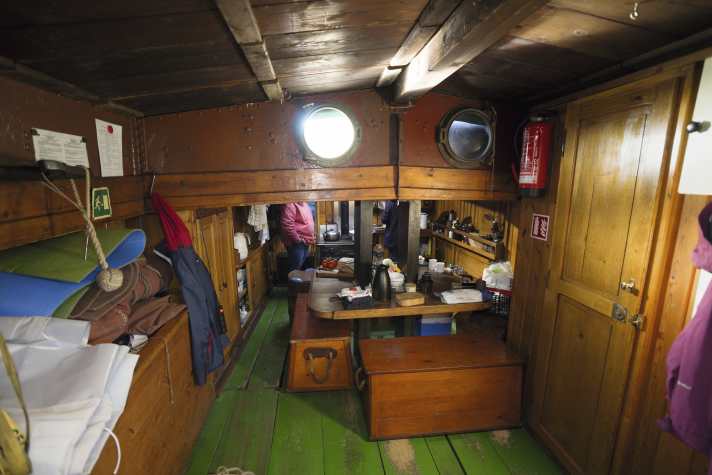
Further forward, to starboard, there is a stylish bathroom with a bathtub - a luxury that the crews of the cargo ship era never dared to dream of. Under the flatter part of the deck, you enter the galley. The massive cooker is fuelled by wood. There are two berths for crew members in the forecastle, the former cabin of the ship's boy.
Familiar atmosphere on board
The owner of the "Johanna", the Hamburg Maritime Foundation, advertises the "familiar atmosphere on board the lovingly restored small cargo ship". The ewer truly offers an impressive glimpse back into the days of cargo shipping. "Johanna" can be chartered for private parties or corporate events. Up to 25 day trips per year contribute to the preservation of the ship. In the summer, the volunteer crew sometimes sets off on trips together, such as the traditional ship regatta "Fyn rundt" in Denmark.
The winter months are used for the necessary work on the ship and for further training of the crew members. Courses are held to prepare them for the examinations for the recreational boating licence for the sea or the VHF radio operating certificate. Other active helpers are always welcome, as are potential (junior) skippers.
Technical data Besanewer "Johanna"
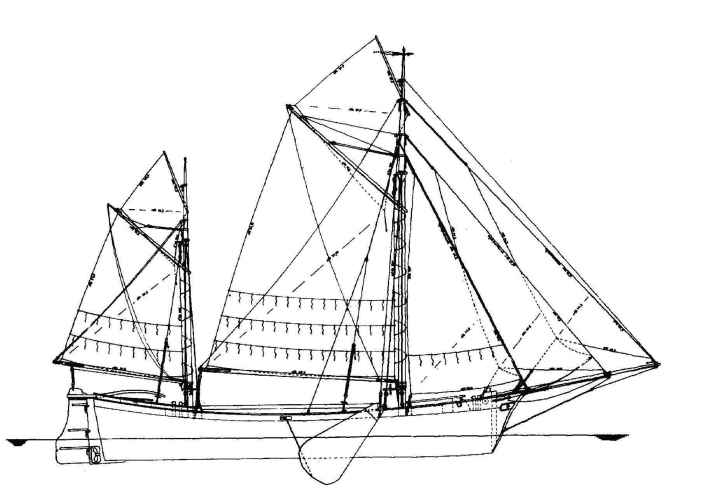
- Shipyard/year of construction: Thormählen (Elmshorn)/1903
- Building material: Steel (formerly iron and wood)
- Rigging: Gaff ketch
- Total length: 24,00 m
- Torso length: 18,62 m
- Width over everything: 4,76 m
- Depth: 1,20 m
- Surveying: 35 GRT
- sail area: 165 m², distributed over 7 sails
- Machine: 50 hp, two-cylinder MODAG diesel
- Number of crew: 4
- Berths: Two berths in each cabin + aft cabin for the crew, six guest berths in the hold
- Day guests: maximum 16
- WC: 1
- Home harbour: Cutter harbour Finkenwerder (Hamburg)
- Owner: Hamburg Maritime Foundation
- Operator: Friends of the Besanewer Johanna e. V.

